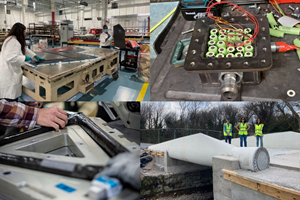Aircraft delays alter carbon fiber supply/demand balance
When Boeing announced in early December that it was officially pushing back the first flight and the first delivery of the 787 Dreamliner to second quarter 2009 and first quarter 2010, respectively, one of the first questions that circulated among our staff centered on the issue of carbon fiber supply.
When Boeing announced in early December that it was officially pushing back the first flight and the first delivery of the 787 Dreamliner to second quarter 2009 and first quarter 2010, respectively, one of the first questions that circulated among our staff centered on the issue of carbon fiber supply. As some of us prepared to depart for the Carbon Fiber 2008 Conference in Charleston, S.C., the question of supply — already on the conference agenda and never a trivial consideration — took on new perspective with the Boeing decision.
Virtually every carbon fiber supplier has announced substantial capacity expansion in the last two years, in large measure to meet increased demand for the 787 and the forthcoming Airbus A350 XWB, as well as several high-profile industrial applications. Because expansion of carbon fiber production is not done idly or inexpensively, these unprecedented announcements said much about the faith suppliers have placed in demand from Boeing and Airbus. By extension, expansion also conveys to the rest of the composites world an overall positive outlook for growth.
Also unprecedented is the mix of fiber types. In the past, carbon fiber manufacturers focused almost exclusively on production of aerospace-grade material, but the number of suppliers that make industrial-grade carbon fiber is growing, and their production capacity is expanding right along with the traditional suppliers. This means that the benefits of increased carbon fiber supply don’t end with Boeing and Airbus: It enables OEMs in other end markets — wind energy, pressure vessels, oil exploration, automotive — to consider use of carbon fiber where supply or grade limitations might have precluded its use in the past. The question for these folks, however, becomes, Can we be confident that, if we invest in the engineering to make a part from carbon fiber, fiber will remain available and relatively affordable?
Given the economic forces unleashed by the boost in carbon fiber supply, what are we to make of Boeing’s delay and the assumed material surplus that will follow? It depends on whom you ask. At last week’s conference, we heard a variety of opinions: Some suppliers said they might consider adjusting to a surplus by temporarily shutting down a production line. Some industry observers predicted a drop in carbon fiber prices, while others thought a little oversupply would provide a net benefit because of the carbon fiber use it helps encourage.
The biggest variable this time — and what makes this supply flux notable — is the crop of new carbon fiber suppliers entering the market. Where once, two years ago, there were just whispers of new carbon fiber manufacturers in Turkey and India, there are now outright production plans from the likes of AKSA and Kemrock. Last week’s conference also unearthed word of a possible new carbon fiber supplier in Iceland, and Russia appears very serious about its desire to develop its own carbon fiber supply base, with Vladimir Putin, himself, weighing in on the material’s importance.
We may not know how the current supply-and-demand relationship will play out, but it is clear that the carbon fiber landscape is changing rapidly, with several new players in the game creating a new competitive environment. For you, the carbon fiber consumer, that could be change for the better.
Related Content
Revisiting the OceanGate Titan disaster
A year has passed since the tragic loss of the Titan submersible that claimed the lives of five people. What lessons have been learned from the disaster?
Read MoreAs 2023 begins, a look back at trending CW topics in 2022
With 2022 now behind us, CW’s editor-in-chief Jeff Sloan takes a look at the CW stories last year that received the most reader attention.
Read MoreA return to JEC World
CW editor-in-chief Scott Francis reflects on the ways in which the composites industry has changed and also stayed the same based on observations from this year’s JEC World.
Read MoreThe (not exactly) new guy at CW
Former CW writer and editor Scott Francis rejoins the brand as editor-in-chief as Jeff Sloan assumes the role of publisher.
Read MoreRead Next
“Structured air” TPS safeguards composite structures
Powered by an 85% air/15% pure polyimide aerogel, Blueshift’s novel material system protects structures during transient thermal events from -200°C to beyond 2400°C for rockets, battery boxes and more.
Read MoreAll-recycled, needle-punched nonwoven CFRP slashes carbon footprint of Formula 2 seat
Dallara and Tenowo collaborate to produce a race-ready Formula 2 seat using recycled carbon fiber, reducing CO2 emissions by 97.5% compared to virgin materials.
Read MoreVIDEO: High-volume processing for fiberglass components
Cannon Ergos, a company specializing in high-ton presses and equipment for composites fabrication and plastics processing, displayed automotive and industrial components at CAMX 2024.
Read More






















